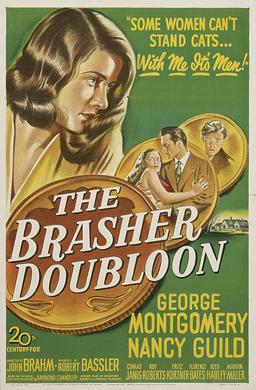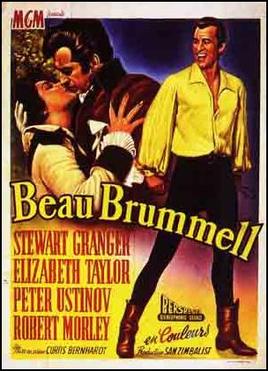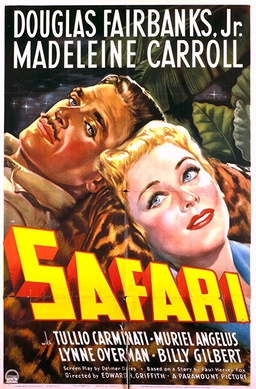Production
The film was based on a poem by Alfred Noyes written in 1906. Film rights were owned by James Burkett, who sold them to Monogram Pictures in 1946. Monogram announced that Noyes would collaborate on the script with Jack De Witt and Renautt Duncan and the budget was to be one million dollars. [1] [2]
Noyes said that the poem would be the last act, and that there would be a parallel storyline set in the present day about a woman who works at the tavern and has problems with her love life. Noyes wanted to do this to keep the tragic ending of the poem but also have a happy ending in the present day. [3] He arrived in Hollywood in April 1947 to inspect the script. [4]
In July 1947, the film was officially added to Monogram's production schedule, [5] but filming was delayed. In April 1950, Monogram announced that it would likely film in June with Florence Marley and Rory Calhoun starring. [6] In July 1950, Louis Hayward said that he would star in Dick Turpin's Ride based on the poem and a script by Robert Libot and Frank Burt, with Harry Joe Brown to produce. Filming was to start in September. [7]
Filming continued to be pushed back. In January 1951, Monogram announced that Hal Chester and Bernard Burton would produce and Charles Coburn would be the film's star, with the script written by Henry Blankfort (who used the pseudonym Jan Jeffries because he had been blacklisted). Filming would start on February 19 under the direction of Lesley Selander at the Motion Picture Center. [8] Wanda Hendrix then joined the cast, [9] followed by Philip Friend shortly before rehearsals and filming started. [10]
Noyes wrote in his autobiography that he was pleasantly surprised by "the fact that in this picture, produced in Hollywood, the poem itself is used and followed with the most artistic care." [11] The film was released in the same year as Columbia Pictures' Dick Turpin's Ride (reissued asThe Lady and the Bandit), also based on a poem by Noyes. Portions of the film were shot at the Corriganville Movie Ranch.
Burkett went on to buy the film rights to several other Noyes titles: Midnight Express, The Walking Shadows, Beyond the Desert, River of Stars and The Last Voyage. [12]

Young Bess is a 1953 Technicolor biographical film made by Metro-Goldwyn-Mayer about the early life of Elizabeth I, from her turbulent childhood to the eve of her accession to the throne of England. It stars Jean Simmons as Elizabeth and Stewart Granger as Thomas Seymour, with Charles Laughton as Elizabeth's father, Henry VIII, a part he had played 20 years before in The Private Life of Henry VIII. The film was directed by George Sidney and produced by Sidney Franklin, from a screenplay by Jan Lustig and Arthur Wimperis based on the novel of the same title by Margaret Irwin (1944).

Dixie Wanda Hendrix was an American film and television actress.
Edward Small was an American film producer from the late 1920s through 1970, who was enormously prolific over a 50-year career. He is best known for the movies The Count of Monte Cristo (1934), The Man in the Iron Mask (1939), The Corsican Brothers (1941), Brewster's Millions (1945), Raw Deal (1948), Black Magic (1949), Witness for the Prosecution (1957) and Solomon and Sheba (1959).

The Brasher Doubloon is a 1947 American crime film noir directed by John Brahm and starring George Montgomery and Nancy Guild. It is based on the 1942 novel The High Window by Raymond Chandler.
King Brothers Productions was an American film production company, active from 1941 to the late 1960s. It was founded by the Kozinsky brothers, Morris, Frank, and Hyman, who later changed their professional surname to "King". They had notable collaborations with such filmmakers as Philip Yordan and William Castle and are particularly remembered today for employing a number of blacklisted writers during the Red Scare of the late 1940s and 1950s. Their films include Dillinger (1945), Suspense (1946), Gun Crazy (1949), Carnival Story (1954), The Brave One, Gorgo (1961), Captain Sindbad (1963), and Heaven With a Gun (1968).
Norman Krasna was an American screenwriter, playwright, producer, and film director who penned screwball comedies centered on a case of mistaken identity. Krasna directed three films during a forty-year career in Hollywood. He garnered four Academy Award screenwriting nominations, winning once for 1943's Princess O'Rourke, which he also directed.
Leonard Spigelgass was an American playwright, film producer and screenwriter. During his career, Spigelgass wrote the scripts for 11 Academy Award-winning films. He himself was nominated in 1950 for the story for Mystery Street and garnered three Writers Guild of America nominations over the course of his career. Spigelgass was also a friend of Gore Vidal who used Spigelgass as the model for Vidal's semi fictionary "wise hack" character in the latter's series of essays about Hollywood.
"The Highwayman" is a romantic ballad and narrative poem written by Alfred Noyes, first published in the August 1906 issue of Blackwood's Magazine, based in Edinburgh, Scotland. The following year it was included in Noyes' collection, Forty Singing Seamen and Other Poems, becoming an immediate success. In 1995 it was voted 15th in the BBC's poll for "The Nation's Favourite Poems".

Beau Brummell is a 1954 British historical film released by Metro-Goldwyn-Mayer. It was directed by Curtis Bernhardt and produced by Sam Zimbalist from a screenplay by Karl Tunberg, based on the 1890 play Beau Brummell by Clyde Fitch. The play was previously adapted as a silent film made in 1924 and starring John Barrymore as Beau Brummell, Mary Astor, and Willard Louis as the Prince of Wales.

The film appearances of movie actor Errol Flynn (1909–1959) are listed here, including his short films and one unfinished feature.

Francis Covers the Big Town is a 1953 American black-and-white comedy film from Universal-International, produced by Leonard Goldstein, directed by Arthur Lubin, that stars Donald O'Connor, Yvette Duguay, and Gene Lockhart. The distinctive voice of Francis is a voice-over by actor Chill Wills.

Way of a Gaucho is a 1952 American Western drama film directed by Jacques Tourneur and starring Gene Tierney and Rory Calhoun. It was written by Philip Dunne and based on a novel by Herbert Childs.

Valentino is a 1951 American biographical film directed by Lewis Allen and starring Anthony Dexter and Eleanor Parker.

Philip Wyndham Friend was a British film and television actor.

Miss Susie Slagle's is a 1946 American drama film directed by John Berry. It was based on the popular novel by Augusta Tucker. The film was Berry's directorial debut and first starring role for Joan Caulfield.

Safari is a 1940 American adventure film directed by Edward H. Griffith and starring Douglas Fairbanks Jr., Madeleine Carroll and Tullio Carminati.

Lorna Doone is a 1951 American adventure film directed by Phil Karlson and starring Barbara Hale and Richard Greene. It is an adaptation of the 1869 novel Lorna Doone by R. D. Blackmore, set in the English West Country during the 17th century.

South of Pago Pago is a 1940 American South Seas adventure film directed by Alfred E. Green and starring Victor McLaglen, Jon Hall and Frances Farmer.
Earl Felton (1909–1972) was an American screenwriter.
Slaves of Babylon is a 1953 American adventure film directed by William Castle and starring Richard Conte and Linda Christian












